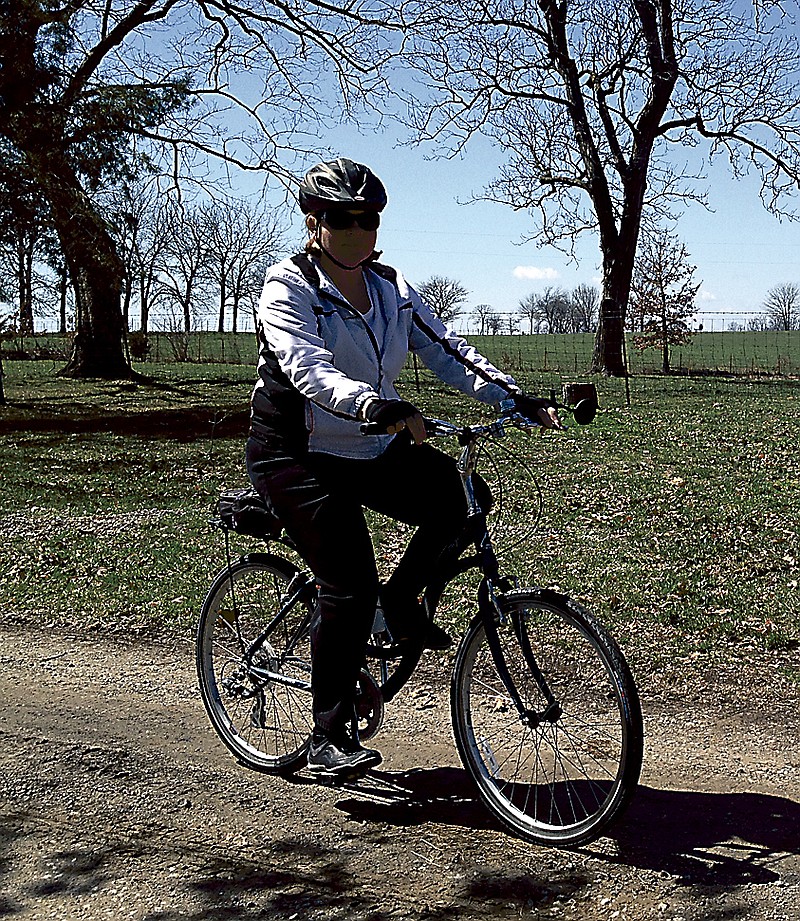By DAVID A. WILSON
Democrat Staff
Peggy Borgmeyer has done a lot of bicycle riding in the last three years, at least partly because her knee pain made it uncomfortable to walk and hike.
Back in the mid 1990s, knee problems took her to a doctor for relief. Finally, in the late 1990s, she had arthroscopic knee surgery.
After surgery, Borgmeyer went to the doctor again and told him the surgery hadn't helped.
He said "Wear thick soled shoes and take glucosamine."
So, she went to a different doctor. That one said her kneecap was being pulled off center.
"It probably was because I wasn't walking right," Borgmeyer said.
She tried physical therapy with some success, but the pain continued. In 2010, she went to a doctor to take X-Rays of her knee. The doctor also wanted to X-Rays of her hips and discovered the likely cause of the problem.
From the X-Rays, he could tell that at some point she had an injury to her hip area. The head of the femur had been broken. The neck of the femur of one leg was thicker and shorter than the other.
Borgmeyer didn't know she had injured her hip, but "it was probably when I fell out of a second story window," she said.
She really doesn't remember the incident which happened when she was three or four, but has heard about it from her older sister and her mother.
According to the story, Borgmeyer was sitting in a window sill and her sister told her to get out of the window. The swingout screen had a hook. When she got down, she apparently pushed against the screen and out she went. The landing - between a sidewalk and rock-edged flowerbed two stories down - knocked her unconscious. She came to, got up and walked so the family thought she was alright.
Apparently she wasn't, but didn't find out until the X-Ray in 2010 found she had probably injured her hip and leg.
In 2010, the doctor said he would do the hip replacement anytime she was ready but Borgmeyer didn't think it was bad enough to do a hip replacement at such a young age. In 2012, it was checked again. Although the hip had maintained itself, it was causing knee pain.
The doctor was surprised it wasn't worse. He thought the bicycle riding, since it is good exercise but low impact, helped maintain the joint. The doctor also commented that she has "great bones," healthy with no osteoporosis.
"That's from growing up on a dairy farm," she said.
As far as the hip surgery was concerned, she said, "I tried to wait until I couldn't endure the pain anymore. But people said it would heal faster when you're younger. The question was, 'Would I rather be active now with a repaired hip or in five or 10 years?'"
That, along with a continually decreasing range of hip motion and an uncertainty of medical insurance in the next few years and possibly doing more damage to the knee leading to needing a knee replacement as well as a hip replacement, led to the decision to do a hip replacement in November 2012.
The surgery was a total hip replacement. The new hip has replaceable parts. If it wears out, the contact surfaces can be replaced without such invasive surgery. It should last 10 to 15 years without further attention.
After the surgery, Borgmeyer was on a walker for six weeks just to make sure the bone didn't split. She said there is really not much physical therapy to be done after hip surgery.
Currently, things are much better.
"There's no pain unless I've been sitting for a long time," she said. "But even that has improved.
"My knees have no pain, but I haven't fully tested them yet with hiking."
She plans to continue bicycling and also do some hiking to try out the new parts when the weather improves.

